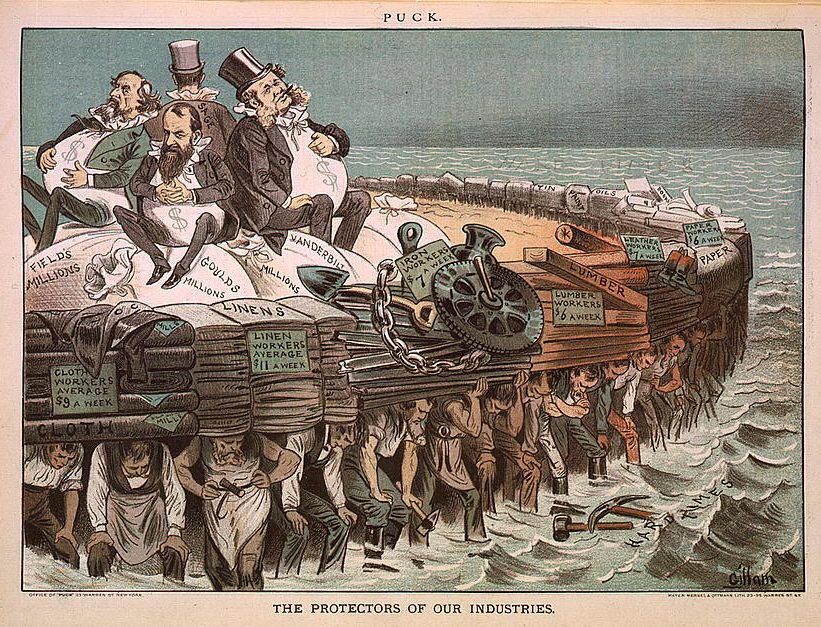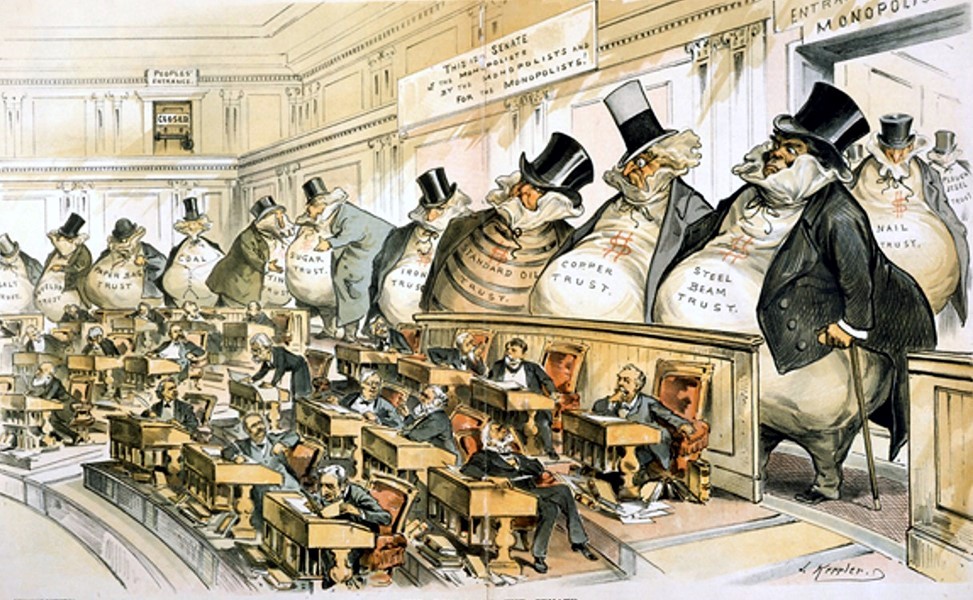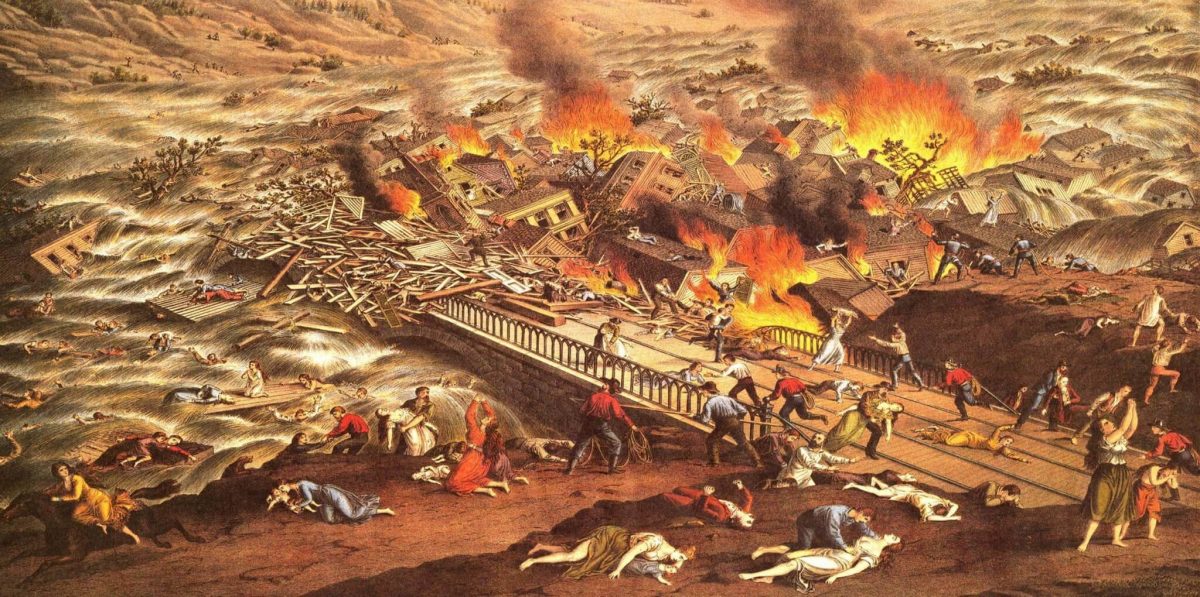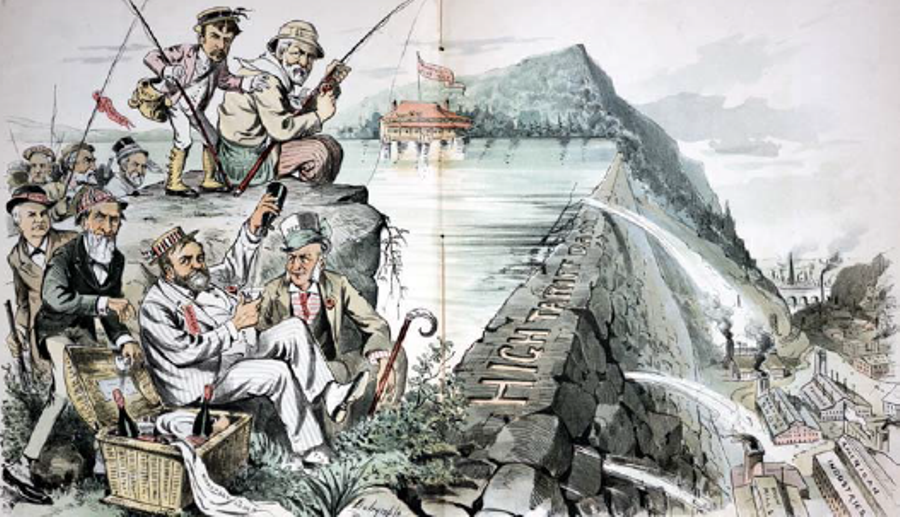The Gilded Age:
From the 1870s to the early 1900s, the United States experienced an era of rapid economic growth. As industrialization expanded, a small number of businessmen dominated American economics. The country’s wealth gap increased greatly and became very apparent to the public. Many citizens resented the top 1% who owned the majority of the nation’s wealth. These business titans also often exploited their workers for profit, resulting in many strikes and worker unions. Later, Mark Twain coined this era the “Gilded Age” since the economic growth presented the appearance of a glittering jewel, but underneath lurked disparity, conspicuous consumption, and corruption (White 2019). Political cartoons became a prime tool to express the public’s anger.
Cartoon #1:

“Protectors of our Industries” was created by Bernhard Gillam and published by Keppler and Schwarzmann in The Puck, a satirical magazine. It was released in 1883, six years before the Johnstown Flood (Gillam 1883). The cartoon depicts the outrageous inequalities that ravaged the Gilded Age. In the image, wealthy businessmen sit on top of a raft that is held up by various types of workers. The businessmen cling to their money, while the workers struggle beneath them. This image captures the public’s frustration with the parasitic power dynamic between the industrial giants and the working class. Businessmen commonly exploited their workers, forcing them to shoulder horrendous and often dangerous working conditions, while experiencing no such circumstances themselves. In the aftermath of the Johnstown Flood, this power dynamic was fundamental to the public’s anger. It was especially infuriating that the figures who were responsible for the disaster were already exploiting many of the victims in the first place, yet faced no consequences for either crime.
Cartoon #2:

“Bosses of the Senate” was created by Joseph Keppler and also published in The Puck on January 23, 1889, less than five months before the Johnstown Flood. This image was heavily circulated in the media (Keppler 1889). It depicts large, overindulgent businessmen representing their corporate interests as they loom over tiny senators. The sign behind the businessmen reads, “This is the Senate of the Monopolists by the Monopolists for the Monopolists.” Businessmen had an overwhelming political influence during the Gilded Age. America’s legal system was corrupt and essentially useless, since dominating industrial interests undermined any pursuit of justice. Despite often acting unfairly and even illegally, businessmen were often able to evade consequences. This corruption became evident in the aftermath of the Johnstown Flood. Despite evidence of their guilt, the South Fork Fishing Club members took advantage of their considerable wealth and influence to avoid any legal liability.
Cartoon #3:

“Andrew Carnegie Plays a Double Roll” was published in the Saturday Globe in 1892, three years after the flood. The cartoon depicts two contradictory sides of Carnegie: the business titan and the philanthropist. Out of all of the prominent business figures that arose during the Gilded Age, Andrew Carnegie is perhaps viewed in the most positive light. Committed to his Gospel of Wealth, Carnegie donated much of his wealth to charity and was known for donating libraries to various towns. However, this image points out that while his philanthropy was commendable, he was also a ruthless businessman. His economic ferocity was perhaps best represented by the Homestead Strike of 1982, where workers in one of his steel factories went on strike in hopes of improved wages and working conditions. Carnegie hired a private security team to meet these strikes with violence (White 2019). Though perhaps more generous than many others, Carnegie was first and foremost an unrelenting businessman who exploited his workers. Carnegie was one of the most prominent members of the South Fork Fishing Club. After the flood, citizens considered him responsible, along with many other club members, for the disaster. Continuing with his common practice, Carnegie donated a library to Johnstown as part of the relief effort (PA Inquirer, August 23, 1889). The public reaction to his actions is well-represented in this cartoon. Johnstown residents were grateful for the library, but that did not excuse the injustices that caused the disaster in the first place.
Cartoon #4:
“The Republican Monopoly Pleasure Club and its Dangerous Dam” was published in Puck magazine on June 12, 1889 (JAHA 2019). It depicts the members of the South Fork Fishing Club picnicking atop the dam, enjoying leisurely activities while the leaking dam floods the city beneath. Though this cartoon captures the Johnstown Flood more literally than the previous cartoons, it is quite similar to them. Even if the Johnstown Flood did not occur, it would not be surprising to find this image in a collection of overexaggerated metaphorical cartoons portraying the injustices of the Gilded Age. Like the previous images, it depicts the blatant outrage towards the businessmen who faced no consequences for their harmful actions. Not only are the club members unconcerned with the horrible tragedy that they are causing, but they still enjoy the same lavish lifestyle while the lives of the citizens who they were already exploiting get washed away.
Overview:
By viewing this series of cartoons, it is evident that the Johnstown disaster was just another dramatic example of the same economic and social power dynamic that pervaded the Gilded Age. The destruction of the South Fork Dam mirrored the collapse of the industrialists’ reputation in the late 1800s. Following the Gilded Age was the Progressive Era, a period where activists advocated for social and political reform in order to address the problems caused by industrialization (White 2019). Public reactions to the political and economic corruption that was exposed by the Johnstown Flood helped launch the United States into this new Progressive Era that would begin within a decade of this disaster.

